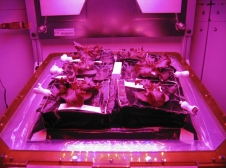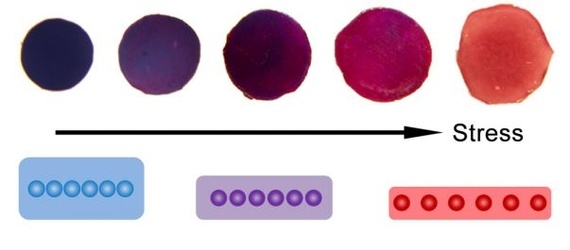In this mornings science roundup on TV3’s Breakfast Firstline show I covered three different topics that had caught my eye over the past 7 days.
The first was about how new research gives further insight into how fibre not only affects bacteria in the gut but also neurons in the hypothalamous to reduce our apetite, the second was on NASA’s new project to grow fresh food in space and finally my favourite topic of nanotechnology and how it is being used to create a new type of pressure sensitive film.
To catch up on the live TV segment click on the video below:
Fibre affects the gut as well as the brain to help reduce appetite.
Scientist have helped to understand the mystery of how dietary fibre can reduce appetite in a nature communications paper published on 29th April 2014 entitled “The short-chain fatty acid acetate reduces appetite via a central homeostatic mechanism“.
Fibre has often been thought to help you to feel full for longer as it is a bulky food and can take a long time to process and digest, however there is also a chemical reaction that occurs which converts fibre to acetate in the gut. In a previous study it was shown that bacteria in the gut were triggered to release appetite suppressing hormones (peptide YY and glucagon-like peptide-1) when they were exposed to this fibre sourced acetate and mice who ate high-fibre diets consumed less food and had gained less weight after 8 weeks than those on a low fibre diet.
Analysis of the colon of these mice found there was much more acetate in the high-fibre fed mice than the low-fibre groups further linking this gut bacteria reaction to appetite supression.
To investigate if it was just reactions in the gut that caused this appetite suppression, scientists then used acetate labelled with 13C (which is a radioactive isotope of the common carbon-12) and were able to track where the acetate traveled to in the body through a PET scan. The scan showed that some of the acetate stayed in the bloodstream and crossed the blood-brain barrier making its way to the hypothalamus part of the brain.

The biodistribution of radioactive labelled acetate using PET scanning showing a fasted mouse (pre) and a mouse after infusion of acetate. The image shows that there is uptake of acetate in the brain, liver and heart. (image taken from original paper)
The hypothalamus region of the brain is critical in the control of hunger and appetite and using High Resolution Magic Angle Spinning (HR-MAS) the researchers were able to see that the acetate accumulated in the hypothalamus after the fibre had been digested. This triggered a series of chemical events leading to the firing of pro-opiomelanocortin (POMPC) neurons, which are known to suppress appetite and created the link between eating fibre and its direct effect on appetite in the brain.
It is thought that one of the reasons for the high levels of obesity in the population is the reduction of fibre intake from 100g per day in the stone age to a mere 10-20g per day in the modern age. Replacing high fibre vegetables with low-fibre convenience ready meals could be one of the reasons for humans overeating and the appetite suppressant not being triggered in our diets today.
So the big question is – could this lead to a new diet pill?
Well injecting acetate into the bloodstream seemed to work on reducing appetite and weight in mice in this study, however acetate is only active for a short amount of time in the body so any type of pill would have to be one that slowly released acetate in the gut over a long period of time, however it does seem to be a possibility.
So where do I find this fibre?
Fibre can be found it fruits, vegetables, buts and seeds, but the specific type of fibre used in this study was inulin which is found in onions, bananas, garlic, asparagus, chicory and Jerusalem artichokes.
How rocket science could produce rocket salad!

Red romaine lettuce plants grow inside in a plant pillow while contained in NASA’s greenhouse made for space. Image credit NASA
If you think growing vegetables in your own garden is difficult, imagine trying to do it in zero gravity!
Last week a new portable greenhouse designed for growing lettuces was taken on to the International Space Station in the hope that astronauts will soon be able to eat their first space-grown salad. If successful it will be the first time that NASA astronauts will have tasted something that was grown in orbit.
The lack of gravity is a big issue when it comes to growing plants in space and ideas on how to stop the soil floating away, preventing water from pooling at the plant roots and controlling which direction growth occurs in all needed to be addressed. The solution was to create a “plant pillow” which has an inbuilt permeable fabric that wicks fluid to the plants roots and encompasses the soil so it stays inside the pillow. As plants sense gravity through cells called statocytes they usually determine their growth direction based on the gravity force sensed, however in space this isn’t possible so the seeds were pre-glued in the correct orientation inside the pillow to ensure that the first shoot penetrates out in the correct direction. Once that initial shoot pokes through the fabric, it will naturally grow towards light which in this case is from a set of red and blue LEDs built into the ceiling of the greenhouse.
Sadly the astronauts will not be able to eat their first crop which should be ready in August as safety regulations require the first lettuces grown to be sent back to Earth for testing to ensure that they are safe to eat without any washing. Once they get the all clear the astronauts should be able to eat the next crop which they hope will be ready in time for a space Christmas dinner salad.
If successful, the ability to grow food in space will become important for any future long-duration space missions and may solve some of the issues about how to sustain life if we were to create human settlements on the moon and Mars.
Colour changing paint shows what it feels

Colour spectrum of gold film based on pressure. Blue is the film in its original form where the nanoparticles are joined together, red is when the pressure applied has been great enough to separate the gold nanoparticles
Metals such as gold are usually shiny because light reflects off the electron clouds at their surfaces. Because photons of light can’t get through these electron clouds they aren’t absorbed by the electrons bound to atoms in metals and so get reflected back to your eye (and you perceive it as a shiny surface).
If you reduce the size of gold down to the nanoscale, the electron cloud at these tiny surfaces resonate with different wavelengths of light depending upon their frequency. Electron clouds from different sizes of nanoparticle gold will be in resonance with or absorb different wavelengths of light. The smallest nanoparticles of gold (around 5nm) will appear red and move to blue as either the size of the particle is increase or particles clump together.
It was purely by accident that while trying to understand nanoparticles and colour scientist Yadong Ying discovered that you could show pressure by breaking up agglomerates of nano gold to create what is described as a “memory sensor” in the April 8 2014 NanoLetters article.
While other pressure sensor films do already exist, they all work by changing the intensity of just one color and trying to differentiate the subtleties between one shade of blue and another can be quite difficult. With this new nano-gold film there is actually a change from blue to red making it much easier for your eyes to detect a difference. By comparing the colour seen to a pressure scale, these simple sensors don’t just indicate if there has been an impact on the surface but also can tell you how strong that impact was.







